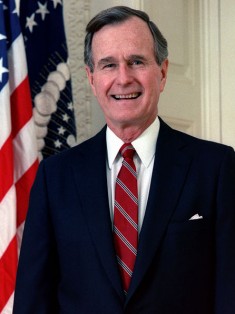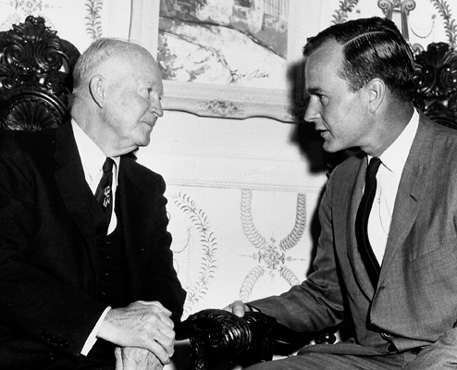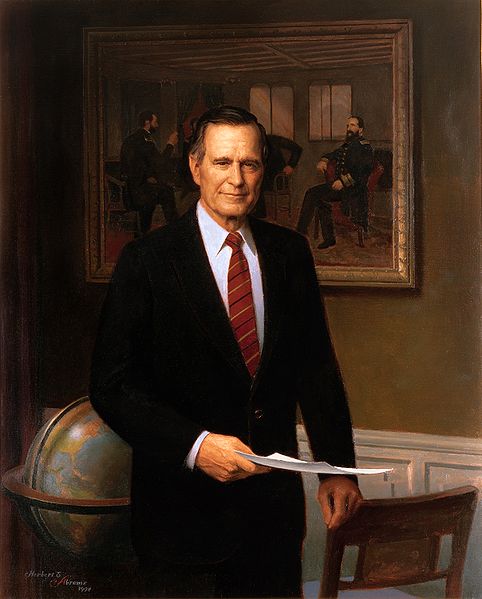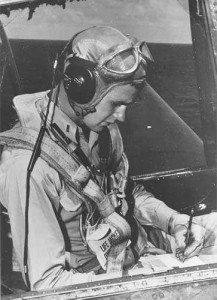| George H. W. Bush | |
|---|---|

| |
| 41st United States President « Previous Next » |
|
| In office | Jan. 20, 1989 – Jan. 20, 1993 |
| V. President | Dan Quayle |
| Political Party | Republican |
| Personal Info | |
| Born | June 12, 1924 |
| Religion | Episcopal |
| School | Yale University |
| Profession | Businessperson (Oil) |
| Signature | |
| Wife | Barbara Pierce |
| Children | George W. Bush Pauline Bush Jeb Bush Neil Bush Marvin P. Bush Dorothy Bush Koch |
| U.S. Presidents 36-43 | |
| 36. Lyndon B. Johnson (1963-1969) | |
| 37. Richard Nixon (1969-1974) | |
| 38. Gerald Ford (1974-1977) | |
| 39. Jimmy Carter (1977-1981) | |
| 40. Ronald Reagan (1981-1989) | |
| 41. George H. W. Bush (1989-1993) | |
| 42. Bill Clinton (1993-2001) | |
| 43. George W. Bush (2001-2009) | |
| List of All the Presidents |
Deeply embedded in his system in rendering public service, the future president felt that in times of war and peace he had to contribute somehow with this principle. He was born on June 12, 1924, in Milton, Mass and was christened by his doting parents, Prescott and Dorothy Bush as George Herbert Walker Bush. Several years later, they transferred to the state of Connecticut. At the prestigious Phillips Academy in Andover, Massachusetts, the young eighteen-year old joined the US Navy. As the youngest pilot of that Navy class, George Herbert Walker Bush was involved in fifty-eight missions in the Second World War. In one operation, the young pilot’s plane was shot down by enemy fire, but he was rescued by friendly forces in a US submarine. For acts of bravery in the battlefield, the Distinguished Flying Cross was bestowed on George Herbert Walker Bush. After the war, the young Bush set his sights in finishing his studies and starting a family.
George Herbert Walker Bush exchanged vows with Barbara Pierce in January 1945. The couple was blessed with six children namely Dorothy, George, Jeb, Marvin, Neil, and Robin (though he died as a child). George Herbert Walker Bush was a standout in his studies and sports; became a baseball team captain and with the Phi Beta Kappa, was accepted as a fraternity member. When he graduated, Bush went to West Texas and excelled in the oil industry.
1980 Vice Presidency and 1988 Presidency
He embarked on a political career in 1980 for a nomination as President for the Republican Party, but he did not make it. Fortunately, Ronald Reagan chose him as his second-in-command. After winning the Vice Presidential race, Bush took care of some issues at home, such as the Federal deregulation, anti-narcotics programs, and numerous state visits in other nations. His star rose in the year 1988 after becoming the Republican standard bearer for President. With Indiana Senator Dan Quayle as his vice-president, George Herbert Walker Bush vanquished Michael Dukakis, a Massachusetts Governor in the presidential election of that year.
The Decline of the Cold War
The late eighties were very significant in the Bush Administration because the Cold War was nearing its end. Communism in the Soviet Union was in its death throes. Before this event, both the US and USSR stockpiled nuclear weapons as a deterrent against each other. Thousands of nuclear missiles were placed in strategic places in both countries ready to be launched and exterminate millions of people. The fears of a nuclear holocaust hang like a “Sword of Damocles.” However, it was not meant to be because on November 9, 1989, the feared Berlin Wall in East Germany finally opened its gates since 1961. The wall was a symbol of a divided Germany after the Second World War. One of the symbols of communism came crashing down after the German populace and soldiers began to tear it apart. The icy relations between Western nations and the Soviet Union began to thaw as well with the fall of the Berlin Wall.
Communist rule in the Soviet satellites was weakening rapidly in the early 1980’s. In the early years of its iron-fisted rule, fifteen nations in Eastern Europe were allied with the USSR, but by the waning period of 1981, these nations freed themselves from the Soviet Union’s grip. By recognizing these former Soviet satellites, President Bush’s influence emboldened them to form an alliance called the Commonwealth of Independent States. After years of seeing the United States as an adversary, these nations followed its lead in the name of world peace.
During those important years, President Bush was in constant communication with Mikhail Gorbachev, the Soviet leader who initiated “perestroika and glasnost.” Both men had warm relations and agreed that both sides should eliminate deadly chemical weapons in their arsenal. Both leaders also wanted to boost trade relations and economic partnership was also discussed in that important meeting.
 In July 1991, President Bush and President Gorbachev met in Moscow to sign a landmark treaty called the Strategic Arms Reduction Treaty, otherwise known as START I. It called for the reduction of both countries long-range missiles and thermonuclear weapons. The treaty was the beginning of a pact between these two superpowers to reduce significant numbers of weapons of mass destruction.
In July 1991, President Bush and President Gorbachev met in Moscow to sign a landmark treaty called the Strategic Arms Reduction Treaty, otherwise known as START I. It called for the reduction of both countries long-range missiles and thermonuclear weapons. The treaty was the beginning of a pact between these two superpowers to reduce significant numbers of weapons of mass destruction.
By September 1991, President Bush decommissioned the thermonuclear short-range weapons from its stockpile. Similar steps were also undertaken to remove the other nuclear stocks. By October, the Soviet satellites followed suit. On Christmas Day of that year, Mikhail Gorbachev ceased to be the president of the USSR. The era of the USSR ended on that day. The next important leader that President Bush had to deal with was the newly-elected leader of Russia, Boris Yeltsin. Both of them ratified another nuclear arms deal in the first month of 1993. The pact called START II called for the reduction of half of the long-range nuclear weapons that was initiated in START I. The reduction was spread for seven years.
As President of the United States of America, George H.W. Bush was in the midst of global changes with historic proportions. The warming of ties with the former USSR ended forty- years of the Cold War and eased international tensions and growing fears of a nuclear conflict. Replacing this uncertain period was an American –Russian partnership, which also left the United States as the most powerful nation on Earth. The breakup of the Soviet Union on the other hand, ushered in a new era, and opened opportunities for President Bush to pursue a “new world order” in strengthening international relations and a significant collaboration among other nations.
New Problems in the Middle East
President Bush heaved a sigh of relief with the improved US-Russian ties, but it was a different matter when it came to Iran, an old enemy from the Middle East. Moreover, the dreaded Lebanese group Hezbollah was being financed and backed by Tehran. Since the mid-1980s, this group has imprisoned scores of Western and American prisoners of war. In the latter years of the 80s, two other terrorist groups, Hamas and the Palestinian Islamic Jihad were openly backed by Iran, threatening the leadership of the Palestine Liberation Organization and the existence Israel—giving President Bush some new problems.
Surprisingly, Bush did not prioritize much of the Middle East region in his foreign policy. A more pressing issue was getting Israel to sign a peace agreement with its hostile Arab neighbors, after waging destructive wars with them for eight years. America has had icy relations with the Islamic Republic of Iran, yet President Bush, on his part, wanted to normalize ties with Iran. In fact, he had a telephone conversation with a man claiming to be Iranian President Akbar Rafsanjani in February 1990 believing that he was talking with him, but later the man was unmasked as a fake. A thorny issue that remained was that American soldiers were still being held in Lebanon by terrorists funded by Iran.
Unexpectedly, President Bush had a falling out with an ally in his conflict with Iran. Iraq’s Saddam Hussein was an enemy of Iran and a supposed friend of the United States. However, all of these ties with Iraq ended with the Iraq’s invasion and occupation of Kuwait, a small oil producing nation in 1990. President Bush was alarmed with Iraq’s aggression. His advisers noted that if they allowed Saddam’s invasion of Kuwait to go unpunished, “He would have access to significant portions of the largest oil depots on the face of the planet. Moreover, by having the fourth-largest army in the world at his disposal, Saddam can manipulate oil prices to become much higher, which he can use to expand his armies and buy stockpiles of chemical weapons. President Bush saw that Iraq was becoming a serious menace to world peace. Iraq’s continued occupation of Kuwait would plunge the Arab region into chaos, and negating the gains he reaped after the Cold War.
 From August 1990 to mid-January 1991, America and the rest of the world tried to reason with Iraq. When that did not work, President Bush punished Saddam by pushing for economic embargos that would force Iraq to recognize Kuwait’s independence. Interestingly, albeit temporarily, Iran and America were one in agreement that Iraq’s actions were totally unacceptable. International outcry, paralyzing embargos and threats of military action did not deter Iraq. Finally, President Bush had enough and he spearheaded Operation Desert Storm. Weeks later, Operation Desert Storm was in full force, which weakened Iraq considerably. Grudgingly, Iran worked hand-in-hand with America in its quest to clips its neighbor’s military might. Its air force grounded many of Saddam’s jets that strayed in Iran’s airspace. Iran also complied with the coalition sanctions against its Arab neighbor. Secretly though, Iranian leaders relished the fact that Iran would become the regional power in the event that Iraq was neutralized.
From August 1990 to mid-January 1991, America and the rest of the world tried to reason with Iraq. When that did not work, President Bush punished Saddam by pushing for economic embargos that would force Iraq to recognize Kuwait’s independence. Interestingly, albeit temporarily, Iran and America were one in agreement that Iraq’s actions were totally unacceptable. International outcry, paralyzing embargos and threats of military action did not deter Iraq. Finally, President Bush had enough and he spearheaded Operation Desert Storm. Weeks later, Operation Desert Storm was in full force, which weakened Iraq considerably. Grudgingly, Iran worked hand-in-hand with America in its quest to clips its neighbor’s military might. Its air force grounded many of Saddam’s jets that strayed in Iran’s airspace. Iran also complied with the coalition sanctions against its Arab neighbor. Secretly though, Iranian leaders relished the fact that Iran would become the regional power in the event that Iraq was neutralized.
Despite his hugely successful foreign policy in dealing with Iraq’s recalcitrant behavior, his diplomatic and military victories did not translate to triumph in his native soil. People could not stand the bearish economy, increasing strife in many cities, and billions of dollars spent on the war in the Middle East. President George H. Bush’s quest for a second term ended when he lost by a landslide to Democrat Bill Clinton. Nevertheless, he was one of the best leaders that America ever had.
